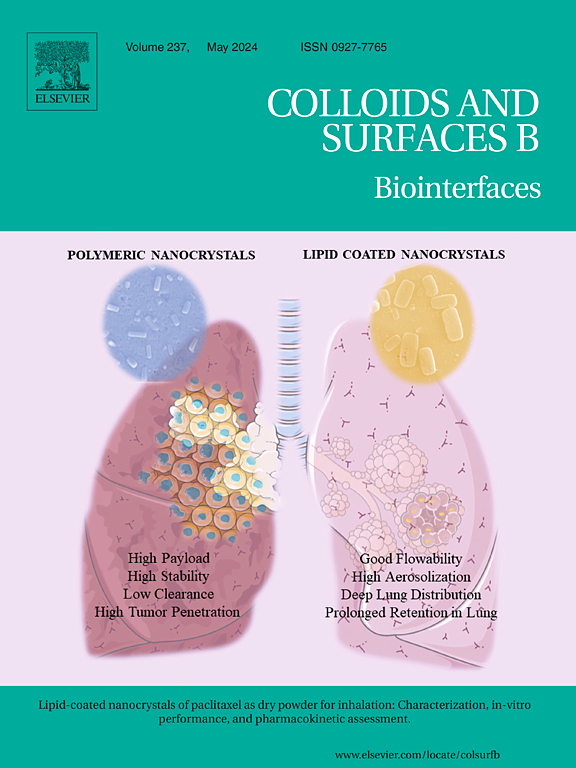具有血脑屏障功能的三层血管结构的同轴生物打印用于神经保护药物筛选。
IF 5.4
2区 医学
Q1 BIOPHYSICS
引用次数: 0
摘要
体外血脑屏障(BBB)结构为研究脑血管功能和开发神经保护药物提供了有利条件。然而,目前开发的血脑屏障模型过于简单,不足以复制体内血脑屏障复杂的三维结构。在这项研究中,介绍了一种利用同轴挤压生物打印技术和两层喷嘴制造具有血脑屏障功能的三层血管结构的方法。将光固化材料掺入同轴喷嘴的内层,光引发剂从外层扩散到内层。因此,在紫外线照射下,只有内层和外层之间的界面处的材料发生交联。去除非交联材料后,可形成两层维管结构。随后,内皮细胞植入后形成三层结构。灌注实验表明,血管结构促进了培养基的连续流动,从而为周围神经组织提供营养和氧气。药物筛选分析表明,该血管结构具有屏障功能,允许小分子药物通过,同时有效阻断大分子药物。综上所述,三层血管结构具有良好的灌注能力和屏障功能,是神经保护药物筛选的理想候选者。本文章由计算机程序翻译,如有差异,请以英文原文为准。
Coaxial bioprinting of a three-layer vascular structure exhibiting blood-brain barrier function for neuroprotective drug screening
The in vitro blood-brain barrier (BBB) structures can offer advantages for studying cerebrovascular functions and developing neuroprotective drugs. However, currently developed BBB models are overly simplistic and inadequate for replicating the complex three-dimensional architecture of the in vivo BBB. In this study, a method is introduced for fabricating a three-layer vascular structure exhibiting BBB function using a coaxial extrusion bioprinting technique with a two-layer nozzle. Photocurable materials were incorporated into the inner layer of the coaxial nozzle, and photoinitiators from the outer layer diffused into the inner layer. As a result, only the materials in the inner layer at the interface between the inner and outer layers underwent crosslinking upon UV exposure. After removing the uncrosslinked materials, a two-layer vascular structure can be formed. Subsequently, a three-layer structure was established after seeding endothelial cells. The perfusion experiments demonstrated that the vascular structure facilitated the continuous flow of culture medium, thereby providing nutrients and oxygen to the surrounding neural tissue. The drug screening analysis indicated that this vascular structure could possess barrier function, allowing the passage of small molecular drugs while effectively blocking macromolecular drugs. Overall, these results suggest that the three-layer vascular structure exhibits excellent perfusion capacity and barrier function, making it a promising candidate for neuroprotective drug screening.
求助全文
通过发布文献求助,成功后即可免费获取论文全文。
去求助
来源期刊

Colloids and Surfaces B: Biointerfaces
生物-材料科学:生物材料
CiteScore
11.10
自引率
3.40%
发文量
730
审稿时长
42 days
期刊介绍:
Colloids and Surfaces B: Biointerfaces is an international journal devoted to fundamental and applied research on colloid and interfacial phenomena in relation to systems of biological origin, having particular relevance to the medical, pharmaceutical, biotechnological, food and cosmetic fields.
Submissions that: (1) deal solely with biological phenomena and do not describe the physico-chemical or colloid-chemical background and/or mechanism of the phenomena, and (2) deal solely with colloid/interfacial phenomena and do not have appropriate biological content or relevance, are outside the scope of the journal and will not be considered for publication.
The journal publishes regular research papers, reviews, short communications and invited perspective articles, called BioInterface Perspectives. The BioInterface Perspective provide researchers the opportunity to review their own work, as well as provide insight into the work of others that inspired and influenced the author. Regular articles should have a maximum total length of 6,000 words. In addition, a (combined) maximum of 8 normal-sized figures and/or tables is allowed (so for instance 3 tables and 5 figures). For multiple-panel figures each set of two panels equates to one figure. Short communications should not exceed half of the above. It is required to give on the article cover page a short statistical summary of the article listing the total number of words and tables/figures.
 求助内容:
求助内容: 应助结果提醒方式:
应助结果提醒方式:


